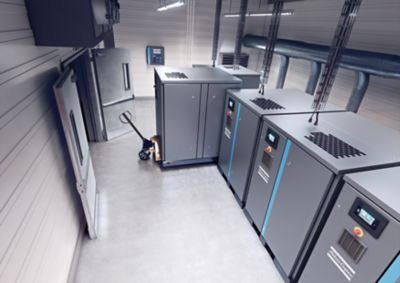Advice for stopping and re-starting air compressors, dryers and gas generators
If you need to reduce production and switch off your air compressors, dryers or gas generators temporarily, we have put together some stopping and re-starting guidelines for you to follow.
How to stop air compressors for periods of time due to factory closure or shutdown
If the compressors are to be stopped for a prolonged period of time the following rules should be applied.
- General recommendation: if production is stopped completely, manually stop the compressors, even if they are integrated in a central controller. If this is not done, it’s possible that the machine will run at minimal capacity to compensate for small leaks in your compressed air network. This may be harmful (for example, it will create condensate in GA machines).
- VSD compressors: Carry out a programme stop, make sure the electrical power supply is left turned on to keep the capacitor bank charged and ready for restart.
- Water-cooled air compressors. After stopping be sure to isolate the water supply. This will stop condensate forming inside the compressor element(s). Don’t forget to turn it back on at start up. Please make sure any air blast cooling systems are turned off.
- Atlas Copco Z compressors – These need the main drive shaft to be manually rotated via the motor drive coupling, 3 complete rotations, once a week. This is to prevent the low pressure and high pressure compression stages from seizing up during a long period of down time. If the Z Compressor is a VSD version, don’t forget to turn the power supply back on after turning the compressor over by hand, to protect the inverter drive capacitors.
- Centrifugal / ZH compressors – should be programmed stopped, leave the power supply on. They need to have the auxiliary oil pump left turned on electrically whilst the compressor is shut down. This will maintain the oil temperature and periodically start up the auxiliary oil pump to circulate warm oil around the bearings during long periods of downtime.
-
Dryers (adsorption or refrigerant) and gas generators can be stopped manually and depressurised if required. For gas generators when depressurising monitor the oxygen level in the machine room.
Starting an air compressor up after long periods of shutdown
Before turning equipment back into operation, a visual inspection is needed.
First turn off the power supply to the air compressor, remove the drive shaft protection guard and turn the drive coupling to check that the compressor is free to turn. If the compressor turns freely, re fit the guard and turn on the power supply to the compressor; turn on the cooling water and air blast cooling system if the compressor is water cooled.
Slowly open the compressor air discharge valve until the air pressure equalises between the compressor and the air net. Start the compressor. The compressor is now back online. If the air compressor is connected to a sequence controller, make sure the compressors are integrated onto the controller/ Optimizer.
For adsorption dryers and gas generators never start up against an empty air-net. When starting close the outlet valve behind the dryer or generator and pressurise the system. Then slowly open the outlet valve to pressurise the air-net, this to avoid high air speeds damaging the adsorption material.
If you require any further assistance in taking your equipment out of operation and back into operation, don't hesitate to contact us.

